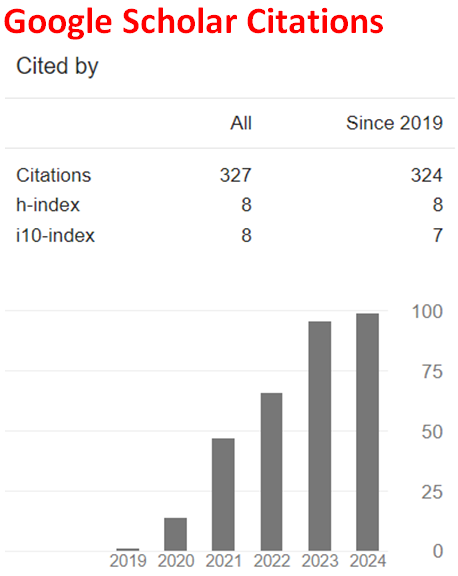Perturbations on Oxybiotin Leading to Biotin. A DFT Treatment
Abstract
In the present computational study, conversion of oxybiotin to biotin by means of oxygen to sulfur replacement has been investigated within the restrictions of density functional theory at the level of B3LYP/6-31++G(d,p). Both of the molecules have not only exothermic heat of formations but also favorable Gibbs free energy of formation values at the standard state. They are electronically stable. Various quantum chemical data accompanying the perturbation considered have been collected and discussed including UV-VIS spectra. The oxygen to sulfur replacement highly affects not only the distribution of molecular orbital energy levels but also the energies of the molecular orbitals in such a way that going from oxybiotin to biotin the HOMO energy level raises up but the LUMO decreases. The both occur at unequal extents thus biotin exhibits some bathochromic effect compared to oxybiotin.
Downloads
References
Pilgrim, F.J., Axelrod, A.E., Winnick, T., & Hofmann, K. (1945). The microbiological activity of an oxygen analog of biotin. Science, 102, 35-36. https://doi.org/10.1126/science.102.2637.35
Duschinsky, R., Dolan, L.A., Flower, D., Rubin, S.H. (1945). “O-Heterohkrtin” a biologically active oxygen analog of biotin. Arch. Biochem., 6, 480-481.
Krueger, K.K., & Peterson, W.H.I. (1948). Metabolism of biotin and oxybiotin by Lactobacillus pentosus 124-2. J. Bact., 55, 693-703.
Shull, G.M., & Peterson, W.H. (1948). The nature of the “spprogenes vitamin” and other factors in the nutrition of Clostridium sporogenes. Arch. Biochem., 18, 69-83.
Hofmann, K., McCoy, R.H., Felton, J.R., Axelrod, A.E., & Pilgrim, F.J. (1945). The biological activity of oxybiotin for the rat and the chick. Arch. Biochem., 7, 393-394. PMID: 21015707.
Axelrod, A.E., Pilgrim, F.J., & Hofmann, K.J. (1946). The activity of dl-oxybiotin for the rat. J. Biol. Chem., 163, 191-194. PMID: 21023639.
Hofmann, K.J. (1945). Furan and tetrahydrofuran derivatives. VI. The total synthesis of dl-oxybiotin. J. Am. Chem. Soc., 67, 1459-1462. https://doi.org/10.1021/ja01225a013
Ohrui, H., Kuzuhara, H., & Emoto, S. (1971). Syntheses with azido-sugars Part III. Preparation of d-oxybiotin. Agric. Biol. Chem., 35, 752-755. https://doi.org/10.1080/00021369.1971.10859969
Reddy, L.V.R., Swamy, G.N., & Shaw, A.K. (2008). A versatile route for the stereoselective synthesis of oxybiotin. Tetrahedron: Asymmetry, 19(11), 1372-1375. https://doi.org/10.1016/j.tetasy.2008.05.008
Shelke, A.M., Rawat, V., Sudalai, A., & Suryavanshi, G. (2014). A short, enantioselective synthesis of 3-epi-jaspine B and (+)-oxybiotin via an intramolecular tandem desilylation oxa-Michael addition strategy. RSC Adv., 4, 49770-49774. https://doi.org/10.1039/C4RA08698H
Hofmann, K., & Winnick, T. (1945). The determination of oxybiotin in the presence of biotin. J. Biol. Chem., 160, 449-463.
Rubin, S.H., Flower, D., Rosen, F., & Drekter, L. (1945). The biological activity of O-heterobiotin. Arch. Biochem., 8, 79-90.
Bender, D. (2003). Nutritional biochemistry of the vitamins. Cambridge: Cambridge University Press.
Zempleni, J., Wijeratne, S.S.K., & Hassan, Y.I. (2009). Biotin. BioFactors, 35(1), 36-46. https://doi.org/10.1002/biof.8
McMahon, R.J. (2002). Biotin in metabolism and molecular biology. Annual Review of Nutrition, 22, 221-239. https://doi.org/10.1146/annurev.nutr.22.121101.112819
Perrin, C.L., & Dwyer, T.J. (1987). Proton exchange in biotin: a reinvestigation, with implications for the mechanism of carbon dioxide transfer. J. Am. Chem. Soc., 109(17), 5163-5167. https://doi.org/10.1021/ja00251a020
Yi, L., Li, H., Zhang, R., & Han, S. (2007). Theoretical study of cooperativity in biotin. J. Phys. Chem. B, 111(51), 14370-14377. https://doi.org/10.1021/jp076914q
Yi, L., Li, H., Zhang, R., & Han, S. (2004). Molecular dynamics simulations of biotin in aqueous solution. J. Phys. Chem. B, 108(28), 10131-10137. https://doi.org/10.1021/jp049207v
Abyar, F., & Novak, I. (2018). Electronic structure of biotin conformers studied with SAC-CI and OVGF methods. J. Phys. Chem. A, 122(8), 2079-2085. https://doi.org/10.1021/acs.jpca.7b12631
Emami, M., Teimouri, A., & Chermahini, A.N. (2008). Vibrational spectra and assignments using ab initio and density functional theory analysis on the structure of biotin. Spectrochimica Acta Part A: Molecular and Biomolecular Spectroscopy, 71(4), 1516-1524. https://doi.org/10.1016/j.saa.2008.05.020
Stewart, J.J.P. (1989). Optimization of parameters for semi empirical methods I. J. Comput. Chem., 10, 209-220. https://doi.org/10.1002/jcc.540100208
Stewart, J.J.P. (1989). Optimization of parameters for semi empirical methods II. J. Comput. Chem., 10, 221-264. https://doi.org/10.1002/jcc.540100209
Leach, A.R. (1997). Molecular modeling. Essex: Longman.
Kohn, W., & Sham, L.J. (1965). Self-consistent equations including exchange and correlation effects. Phys. Rev., 140, 1133-1138. https://doi.org/10.1103/PhysRev.140.A1133
Parr, R.G., & Yang, W. (1989). Density functional theory of atoms and molecules. London: Oxford University Press.
Becke, A.D. (1988). Density-functional exchange-energy approximation with correct asymptotic behavior. Phys. Rev. A, 38, 3098-3100. https://doi.org/10.1103/PhysRevA.38.3098
Vosko, S.H., Wilk, L., & Nusair, M. (1980). Accurate spin-dependent electron liquid correlation energies for local spin density calculations: a critical analysis. Can. J. Phys., 58, 1200-1211. https://doi.org/10.1139/p80-159
Lee, C., Yang, W., & Parr, R.G. (1988). Development of the Colle-Salvetti correlation energy formula into a functional of the electron density. Phys. Rev. B, 37, 785-789. https://doi.org/10.1103/PhysRevB.37.785
SPARTAN 06 (2006). Wavefunction Inc. Irvine CA, USA.
Dewar, M.J.S., & Dougherty, R.C. (1975). The PMO theory of organic chemistry. New York: Plenum/Rosseta.
Durant, P.J., & Durant, B. (1972). Introduction to advanced inorganic chemistry. London: Longman.

This work is licensed under a Creative Commons Attribution 4.0 International License.


